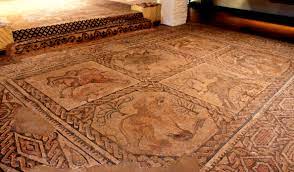El origen del casco urbano de Algarinejo es de época romana, según los hallazgos obtenidos en las excavaciones arqueológicas realizadas en el año 1990 en Huerto Megías, donde se detectaron los restos de una villae (casa rural romana), de los siglos I y IV dedicada a la producción agrícola. Sin embargo, por compartir Algarinejo territorio e historia con la comarca del Poniente granadino, es muy probable que con anterioridad, este mismo lugar estuviese ocupado por íberos, concretamente bastetanos, un pueblo que vivía en aldeas protegidas con murallas, tanto en las altiplanicies de la sierra como en las depresiones de las vegas, donde cultivaban cereales y comerciaban con vino y aceite.
Recientes excavaciones en la Avenida de la Constitución, han desvelado restos de muros y pavimentos de una edificación ibero-romana, así como varios enterramientos correspondientes a una necrópolis cuya cronología no ha sido aún datada con exactitud.
La forma de poblamiento de la época romana es la villae.
Son pequeños asentamientos romanos que constituían una unidad independiente de explotación agropecuaria, y que debieron aprovechar, a su vez, primitivos asentamientos bastetanos. Las villae serían los precedentes de las alquerías árabes, y de los cortijos y cortijadas que en la actualidad se reparten a centenares por el territorio de Algarinejo. Además de los cortijos, en Algarinejo son múltiples los vestigios heredados de los romanos que aún existen: molinos, norias, hornos, pozos, acequias, balsas y minas. Estas sociedades romanas complementaban su actividad agroganadera con algunas industrias artesanas entre las que destaca la minería del hierro.
Pero, fue la ganadería la actividad que alcanzó mayor auge bajo el dominio romano, estableciéndose una importante red de caminos pecuarios que conectaban los pequeños vicus – agrupaciones de viviendas rurales- entre si, situadas en los cruces de paso y en las veredas próximas a las vegas. La vereda Real Loja-Priego es heredera, sin duda, de este trazado romano. En la actualidad existen multitud de vestigios de esta antigua red de caminos pecuarios que atraviesa el municipio, como tramos de calzada, importantes poblados, balsas o piletas que incluso hoy en día se mantienen en uso.

